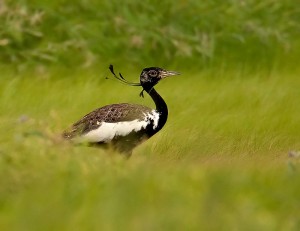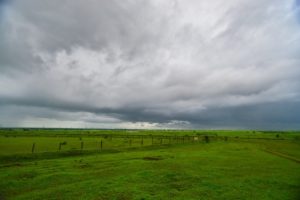If the florican is to survive
One of the most riveting sights I have witnessed in the wilds—dramatic encounters with tiger, elephants et al included—is the mating ritual of the lesser florican. T his was in Velavadar National Park, Gujarat. Spread before me was a sea of gently swaying golden grass, looking not unlike waves rising and falling to the rhythm of the wind. Out of this azure landscape, a bird––no bigger than domestic fowl—shot straight up in the air, higher than the grass- about two metres high, and then floated gently down. He was beautiful, head crowned with a kalgi, shimmering black body, silvery white wings that opened to reveal dazzling colour…
his was in Velavadar National Park, Gujarat. Spread before me was a sea of gently swaying golden grass, looking not unlike waves rising and falling to the rhythm of the wind. Out of this azure landscape, a bird––no bigger than domestic fowl—shot straight up in the air, higher than the grass- about two metres high, and then floated gently down. He was beautiful, head crowned with a kalgi, shimmering black body, silvery white wings that opened to reveal dazzling colour…
What a tremendous spectacle—the endangered lesser florican tirelessly, earnestly performing its nuptial ritual. Every few minutes, the bird burst into the horizon like a tightly coiled spring suddenly released, displaying its fine plumage in a flurry of wing beats accompanied by a rattling call. I timed the ritual—the bird leapt no less than seven times over 11 minutes. I read later that he may do this ‘yo-yo’ routine about 400 times a day—to woo his largely invisible (to us) bride.
Unfortunately, this phenomenon is getting rarer by the day with the population and the habitat of the florican declining drastically. The bird is virtually endemic to India, though there are a few occasional reports from Pakistan and Nepal. Once widespread and common in the plains and open country (though not in the northeast and the Brahmaputra Valley, which was the stronghold of another bustard species, the critically endangered Bengal florican), its breeding habitat is currently restricted to small patches in northwestern India, particularly Gujarat, northern Maharashtra, eastern Rajasthan and western Madhya Pradesh. The bird flies in at the onset of the monsoon for breeding, and takes off post the wet season to its non-breeding habitats, presumably to peninsular and northern Indian grasslands, though where it goes—and why—is one of nature’s unsolved mysteries.
The lesser florican Sypheotides indica is the smallest bustard of the world, and one of the three resident bustards of India, the most critically endangered being the great Indian bustard—the focus of an earlier column and of which only about a 100 remain.
The situation of the lesser florican is also of grave concern, with some estimates putting the population to fewer than 2,000. A rapid survey by Bhardwaj et al in 2011 in 91 grasslands of northwest India shows the sharp decline—65 per cent lesser than reported 15 years ago in a comprehensive survey (Sankaran, 1999). The florican was detected in 26 per cent sites during 2010 as opposed to 41 per cent in 1999. The survey reports severe degradation, fragmentation and encroachment of grasslands.
Why has the lesser florican taken such a beating?
 Much of the answer lies in the fact that the florican is a creature of the grasslands––easily the most endangered, ill-managed, misunderstood and undervalued ecosystem in the country—even though they support some of our most threatened wildlife including the great Indian bustard, floricans, wolves, blackbucks, hispid hare, pygmy hog, rhinos, nilgiri tahr, to name a few. Collaborates a report of the Planning Commission’s Task Force “Grasslands and deserts are the most neglected ecosystems”, going on to stress the importance of grasslands both from the point of view of biodiversity as well for the rural economy, as these are vital grazing areas for livestock—from where half of the fodder for India’s 500 million livestock is sourced. It must, however, be pointed out, that the few remaining grasslands today are threatened by severe grazing pressure, which reduces grass cover – the source of food and concealment to birds when they are vulnerable to hunting, leads to nests and eggs getting trampled by livestock, and also spreads invasive weeds like Prosopis that eventually take over and drastically reduce available florican habitat. Grasslands also offer intangible, but vital benefits as important catchment for rivers, streams, reservoirs, village ponds, marshes, etc., thus playing a vital role in the hydrological regime.
Much of the answer lies in the fact that the florican is a creature of the grasslands––easily the most endangered, ill-managed, misunderstood and undervalued ecosystem in the country—even though they support some of our most threatened wildlife including the great Indian bustard, floricans, wolves, blackbucks, hispid hare, pygmy hog, rhinos, nilgiri tahr, to name a few. Collaborates a report of the Planning Commission’s Task Force “Grasslands and deserts are the most neglected ecosystems”, going on to stress the importance of grasslands both from the point of view of biodiversity as well for the rural economy, as these are vital grazing areas for livestock—from where half of the fodder for India’s 500 million livestock is sourced. It must, however, be pointed out, that the few remaining grasslands today are threatened by severe grazing pressure, which reduces grass cover – the source of food and concealment to birds when they are vulnerable to hunting, leads to nests and eggs getting trampled by livestock, and also spreads invasive weeds like Prosopis that eventually take over and drastically reduce available florican habitat. Grasslands also offer intangible, but vital benefits as important catchment for rivers, streams, reservoirs, village ponds, marshes, etc., thus playing a vital role in the hydrological regime.
Yet, grasslands are viewed as ‘wastelands’, and are being destroyed, degraded and razed for real estate, industry, roads, canals, agriculture-largely cash crops like tobacco, soya, cotton etc. Another key threat is gross mismanagement, with tree plantation being done on a massive scale to ‘green’ what has been mistakenly dismissed as ‘wastelands’, turning grasslands into monoculture woodlands with disastrous effects for the species they sustain.
The first step in saving the florican is to understand the nature of the ‘beast’. For one, the lesser florican is not confined to ‘sanctuaries’ or government grasslands., It largely exists outside the PA network, and frequents croplands, particularly in the breeding season in order to feed extensively on insects to meet its protein requirements needed to fuel its high-energy nuptial ritual
A major threat to the florican, therefore, is the drastic change in cropping pattern for instance, from traditional crops like urad, favoured by the bird, to cash crops like soya and cotton. Another key concern is the use of pesticides (even more intensive in cash crops) which badly affects insects, larvae, plant shoots and grains which dominate the bird’s diet.
Indiscriminate development, even those touted as ‘green projects’, particularly the setting up of windmills, has led to the abandonment of habitats by these birds.
Less than five per cent of the lesser florican’s habitat exists under the Protected Area network. Surveys indicate that the protected grasslands are faring better and are favoured more by the florican. It’s important, therefore, to protect grasslands—perhaps as conservation or community reserves or eco-sensitive zones; and to integrate livelihood concerns with conservation.
While it is critical that changes in land use of lesser florican habitat be regulated, there needs to be multi-layered and different strategies to protect the florican, particularly since a large part of these grasslands are under private ownership. It’s crucial that we evolve and facilitate a participatory approach involving and incentivising local communities. Other key steps that we need to urgently adapt are protection of ‘core areas’ by making them secure and inviolate during the breeding season, an immediate halt to plantations, promotion of organic farming in and around florican habitats through provision of training, marketing aid and incentives, etc. Research and monitoring of the florican across its range, especially its non-breeding sites must be facilitated.
Equally important is to establish a national policy on the conservation and management of grasslands in India, within and outside PAs, as well as a national policy on grazing and preserving of pasture lands.
These and other such recommendations are given in the Ministry of Environment & Forests‟
Guidelines for State Action Plans for Bustards‟ Recovery Programmes that must be implemented on an urgent basis by States — guided, monitored and aided by the centre, and other relevant scientific and research institutions.
(The columnist is senior consultant, WCS India, and trustee of ‘Bagh’. She is also a member of the National Board for Wildlife).
This column was first published in The Pioneer on 11 September 2013.
Photocredits:
Lesser Florican: Ramki Sreenivasan
(The last remanent) grasslands of Sardarpur Wildlife Sanctuary: MD Madhusudan
the sketch is by Pramod Patil
Nice, informative and precise article. Saving floricans is immensely dependent of landscape level-community dependent model. All the breeding sites needs to be protected with utmost priority……
Thanks for sharing this valuable information, useful for conservation of species.